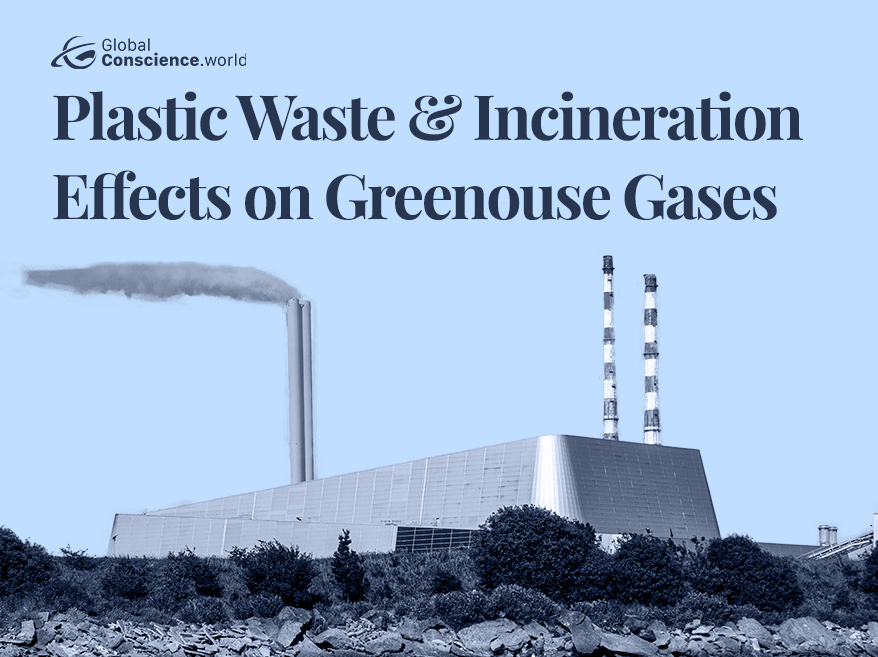Plastic waste and incineration effects on GHG emission and sustainable agenda

The sustainability of the earth is in danger because the planet has become home to plastic made products. This is the reason why the temperature of the earth is increasing and getting warmer. Since the second half of the 20th -century, plastic proliferation has exacerbated climate change, extensive use of non-biodegradable material is the primal cause of this problem. Waste to energy incineration is often described as a low source of carbon energy, however, the facts suggest that energy production by incineration is almost 2 times more than compared to the average grid intensity of European electricity generation plants by the combustion of fossil fuels. So many current studies and reports identified that much of the currently used incinerators’ feedstock can be recycled and it is not only economically feasible and beneficial but for the environment overall. Nevertheless, incineration is a low source of energy in poor economies but an inept way to discard waste. Since 91 percent of plastic is only used once and then discarded and this waste accumulates in landfills and oceans, this behavior of the people is undermining Europe’s efforts and strategies to reach net zero-sum climate change emission by 2050.
Human beings and natural sources both emit carbon dioxide, men produce carbon emissions of upto 87% and the main sources of carbon dioxide in the environment are cement manufacturing units (4%), deforestation (9%), and combustion of fossil fuels. It goes into the air and traps heat into the air and causes global warming. Natural resources such as decomposition, respiration, and ocean release are also the major natural sources of carbon dioxide emissions. Since the industrial revolution, carbon emission has extensively increased up to dangerous levels. The prime cause is that human activities have upset the natural balance of carbon emission through the natural sink removal process by adding extra carbon dioxide into the atmosphere. Currently the countries that produce the more carbon emission include, China (9.3 GT), United States (4.8 GT), India (2.2 GT), Russia (1.5 GT), Japan (1.1 GT), Germany (0.7 GT), South Korea (0.6 GT), Iran (0.6 GT), Canada (0.5 GT), and Saudi Arabia (0.5 GT), as per JSON statistics of 2021. From 1850-1900 to 2010-2019 the global temperature had been 0.8 oC to 1.3 oC and it is being projected that if the current situation remains constant the global temperature will reach 2.0 oC. Since 1950, carbon emission concentration has continued to rise and on average it has reached 410 ppm, for CO2, 1866 ppb for methane CH4, 332ppb for nitrous oxide by the end of the year 2019. The reason is that hot extreme heat waves have become more frequent since 1950, and extreme cold waves have become less frequent which are the main drivers of more flooding and less ice caps on World Mountains (IPCC climate change report 2021). Besides heat wave’s effect on land and oceans, marine heatwaves have also increased substantially which is an alarming situation for aquatic and marine life and it is harbingering a great danger. Consequently, because of the widespread plastic lifestyle, the global community failed to keep the temperature below the point of 1.5◦C in 2019. Successively, it has become a significantly growing issue as oceans are overwhelmed due to plastic pollution in addition to many other pollutants. By including many other human activities, plastic proliferation is threatening the global environment on a large scale. Nearly 850 million metric tons of greenhouse emissions due to plastic incineration were added to the atmosphere by 2019. Furthermore, it is being projected that it may reach up to 1.34 gigatons by 2030 which is equal to 295 new 500-megawatt coal-based plants and by 2050 it will reach 2.8 gigatons of CO2, equivalent to 615 megawatts to coal-based plants overall. The cumulative GHG emission will be 56 gigatons CO2e by the year 2050 (hidden cost of plastic 2019). This is approximately equivalent to 10 to 13 percent emaining carbon budget for the planet earth. The primal reason for this carbon production is bigwig business activities and their profit maximization objective behind this: such as petrochemical and plastic manufacturing units have expanded their business to large scale and they are planning further for massive expansion. Therefore, currently, Carbon Dioxide Emanations highly depend upon human sources, subsequently, greenhouse gases are emitted by every piece of plastic which releases at each stage of plastic creation, fossil fuel extraction, transportation, refining manufacturing and managing. Plastic is made of a long chain of shorter molecules of synthetic organic polymers. So, it does not decompose, thereby; it accumulates in waterways, agricultural soil, rivers and oceans. According to the skimmers report of marine and ecosystem (2019), the fishing industry is also on the verge of collapse due to this non decomposable long array of polymers and its annual cost is 13 billion USD which is including the overall consumer cost of 75 billion USD a year. The overall environmental cost is 650 billion to 1.2 trillion due to air pollution, loss of blue economy, and due to consumer goods inept production. The ackaging industry demands approximately 40 percent of plastic. By the year 2015, 16 MMT GHG emissions were released globally due to incineration. In 2015, while signing the Paris agreement the global fraternity and overall countries agreed and ensured that they will try to lower the global carbon emission. Currently, China and the USA are the big producers of plastic-based products. The Minderoo Foundation statistics of 2019 reveal that the world’s biggest single use plastic waste companies in million metric tonnes are: Exxonmobil 5.9, Dow 5.6, Sinopec 5.3, Indorama 4.6, Saudi Aramco 4.3, Yonde Basel 3.9, PetroChina 4 and Reliance produces 3.1 million metric ton plastic annually. The world’s worst plastic polluter companies are Coca-Cola, Pepsico, Nestle, Unilever, Mondelez, Mars, Procter and Gamble, Philip Morris International, Colgate Palmolive, and Perfetti. However, despite all uncertainties effects of plastic incineration are real and significant; hence they required immediate actions on the issue. Since gathering the data of plastic effects on human beings and the ocean requires extensive funding and strong will to determine the intensity of the problem which is exacerbating day by day. Certainly, data availability about the effects of plastic proliferation on earth is an issue; in this regard government, nonprofit organizations, environmentalists, and policymakers can play a central role.
Today, despite all efforts, the world has failed to achieve the goal to lower the emission of greenhouse gases by the year 2019 because plastic proliferation is the prime cause of climate change and it is the major source of upheaval in environmental pollution which is exacerbating global warming. 2019 was the second warmest year of the 21 st century, the year observed the warmest decade ever recorded (2010-2019). Further, when plastic reaches oceans, rivers, and waterways it choked and clogged them, particularly damaging sewer and water supply systems. In 1950, it was only 2 million metric tons per year annual production which has approached 380 million MT by the year of 2015 at the end of the year, only in the year of 2015, 8,300 MMT of virgin plastic was produced (Center of environment and international law report the hidden cost of plastic (2019)).
The statistics of the Minderoo Foundation (2019) show why the blue economy is extremely in danger due to plastic extraction. Since the Asian Rivers emit the most plastic into the oceans which are around 81 percent, Chang Jiang (1,469,481), Indus (164,332), Huang He (12,249), Hai He (91,858), Nile (84,792), Meghna Brahmaputra Ganges (72,845), Zhujiang (52,958), Amur (38,267), Niger (35,196), Mekong (33,431) in kilograms annually. African rivers release 8.0 percent, South America 5.5 percent, north and central rivers of America 4.5 percent, Europe 0.6 percent, Australia and specific releases 0.4 percent plastic bottles in oceans. Oceans and land have received 56 percent plastic waste annually and the prime reason for this is extensive human business activities.
Almost all kinds of plastic are made from oil and gas, the process emits billions of tons of GHG. 4 percent of the world’s petroleum is used into the plastic manufacturing units, 4 percent burns in the refining process; circulation of plastic is also causing trouble as only less than 12 percent is recycled. With the poorly regulated incineration in those countries where an institutional check is very poor, plastic proliferation is a potential threat. There are so many solutions available which can be used to mitigate the after-effects of plastic waste effectively. Some of the following can be the best possible solutions: recycling of plastic, widespread use of organic and reusable products, imposition of high tax rate and regulation on the single-use of plastic, it will hamper the larger extraction of virgin plastic and exert pressure on manufacturers and the biggest producers of plastic packaging companies. Subsequently, they will move towards more sustainable packaging. In a nutshell, the more plastic we produce the more fossil fuels we will need and it will aggravate the situation further, as it is a known fact that oceans and land are the natural sinks for carbon dioxide and greenhouse gases. So we need to take action on an immediate basis for sustainable development and the welfare of the living being on earth.
References
Aretoulaki, e., ponis, s., plakas, g., & agalianos, k. (2021). Marine plastic littering: a review of socio economic impacts. Journal of sustainability science and management, 16(4), 277-301.
Hamilton, l. A., feit, s., muffett, c., kelso, m., rubright, s. M., Bernhardt, c., … & labbé-bellas, r. (2019). Plastic & climate: the hidden costs of a plastic planet. Center for international environmental law (ciel)
Sixth Assessment Report – IPCC
https://meam.openchannels.org/


